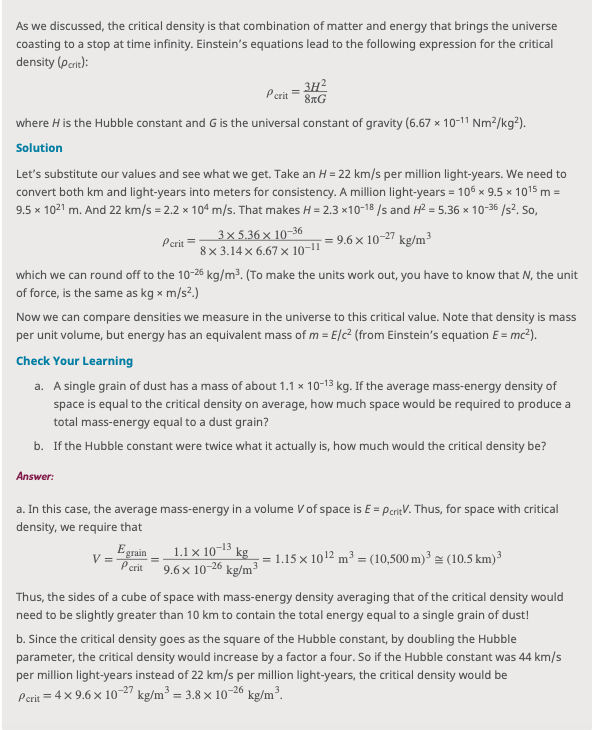Answered step by step
Verified Expert Solution
Question
1 Approved Answer
Example 29.1 shows how to calculate critical density of theuniverse.Copy this example to the end of the critical density calculationthat?crit = 9.6 x 10^-27 kg/m^3.

Example 29.1 shows how to calculate critical density of theuniverse.Copy this example to the end of the critical density calculationthat?crit = 9.6 x 10^-27 kg/m^3.
As we discussed, the critical density is that combination of matter and energy that brings the universe coasting to a stop at time infinity. Einstein's equations lead to the following expression for the critical density (pcrit): Perit where H is the Hubble constant and G is the universal constant of gravity (6.67 x 10-11 Nm/kg). Solution Let's substitute our values and see what we get. Take an H = 22 km/s per million light-years. We need to convert both km and light-years into meters for consistency. A million light-years = 106 x 9.5 x 105 m = 9.5 x 101 m. And 22 km/s = 2.2 x 104 m/s. That makes H = 2.3 x10-18 /s and H = 5.36 x 10-36 /s. So, 3H 8nG Perit= 3x5.36 x 10-36 8x3.14 6.67 10-11 which we can round off to the 10-25 kg/m. (To make the units work out, you have to know that N, the unit of force, is the same as kg x m/s.) Now we can compare densities we measure in the universe to this critical value. Note that density is mass per unit volume, but energy has an equivalent mass of m= E/c (from Einstein's equation E = mc). Egrain Perit V = = 9.6 x 10-27 kg/m Check Your Learning a. A single grain of dust has a mass of about 1.1 x 10-13 kg. If the average mass-energy density of space is equal to the critical density on average, how much space would be required to produce a total mass-energy equal to a dust grain? b. If the Hubble constant were twice what it actually is, how much would the critical density be? Answer: a. In this case, the average mass-energy in a volume V of space is E= PcritV. Thus, for space with critical density, we require that 1.1 x 10-3 kg 9.6 x 10-26 kg/m 1.15 x 102 m (10,500 m) = (10.5 km) Thus, the sides of a cube of space with mass-energy density averaging that of the critical density would need to be slightly greater than 10 km to contain the total energy equal to a single grain of dust! b. Since the critical density goes as the square of the Hubble constant, by doubling the Hubble parameter, the critical density would increase by a factor a four. So if the Hubble constant was 44 km/s per million light-years instead of 22 km/s per million light-years, the critical density would be Perit = 4x9.6x10-27 kg/m = 3.8 10-26 kg/m.
Step by Step Solution
★★★★★
3.34 Rating (148 Votes )
There are 3 Steps involved in it
Step: 1
The solut...
Get Instant Access to Expert-Tailored Solutions
See step-by-step solutions with expert insights and AI powered tools for academic success
Step: 2

Step: 3

Ace Your Homework with AI
Get the answers you need in no time with our AI-driven, step-by-step assistance
Get Started


